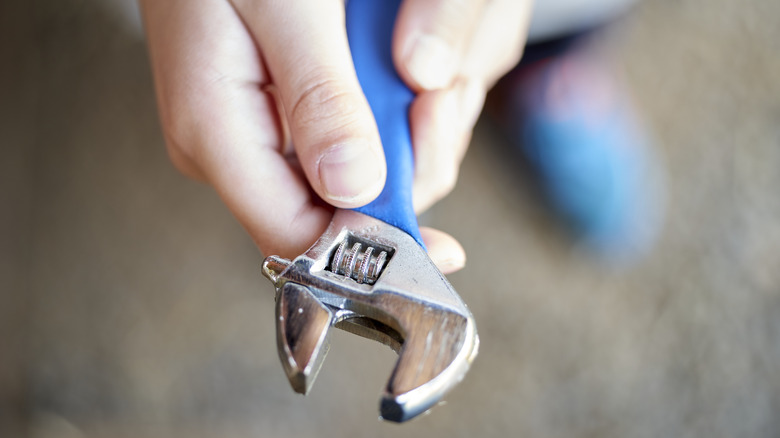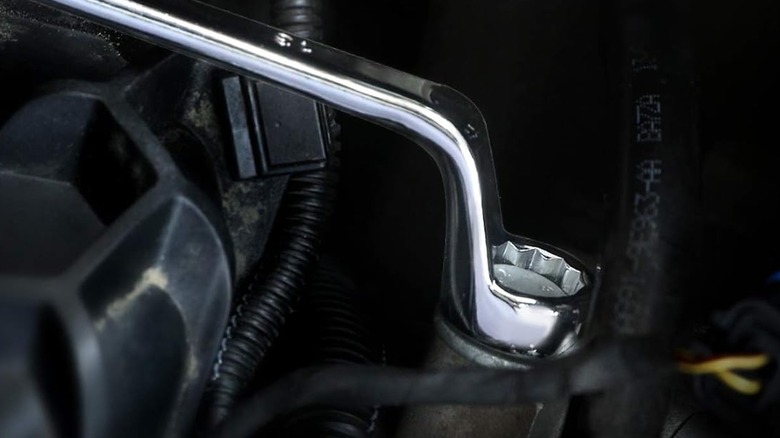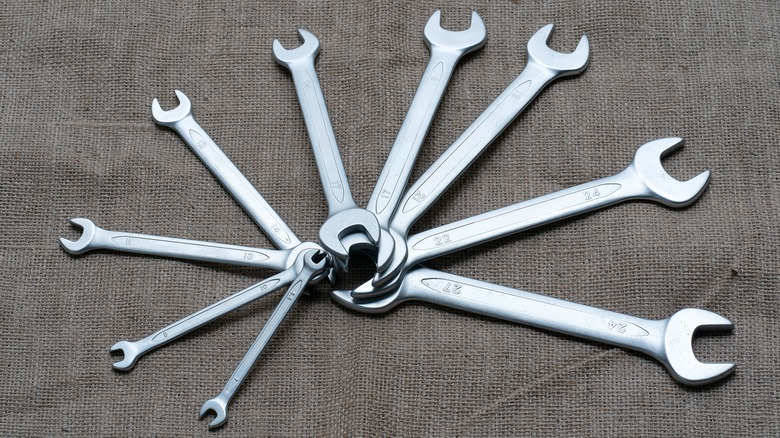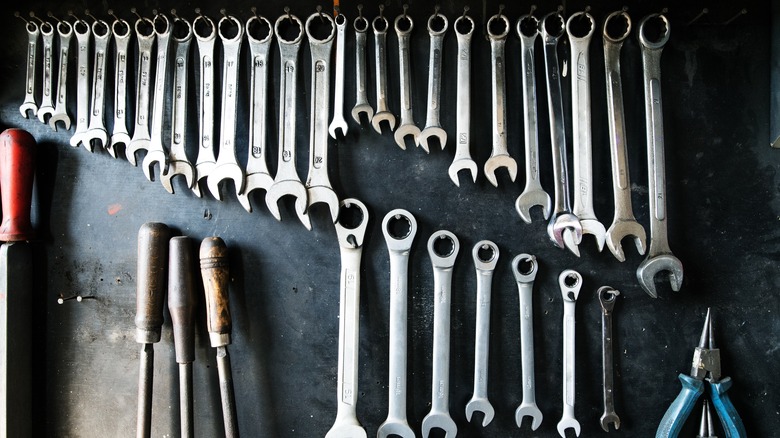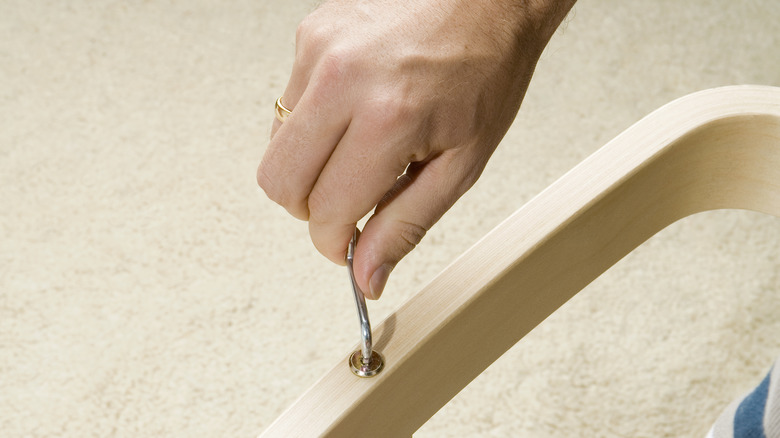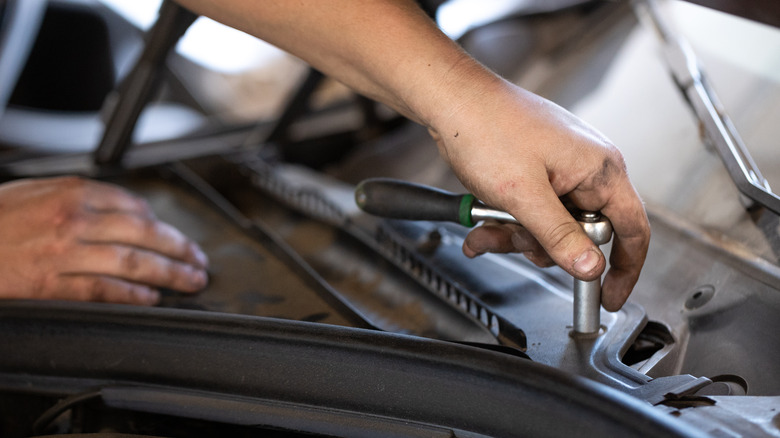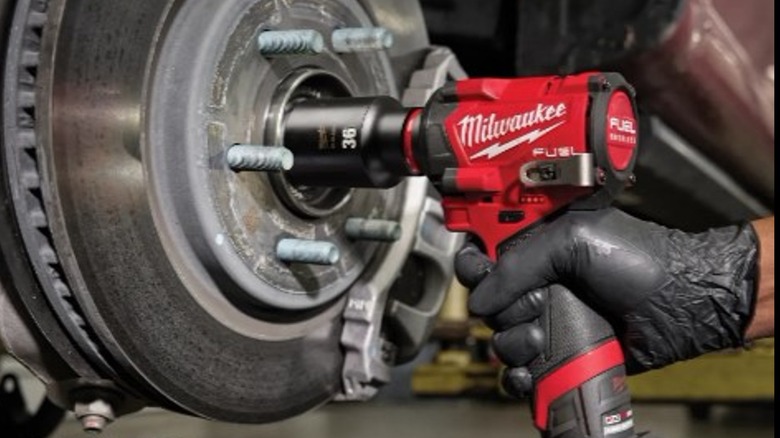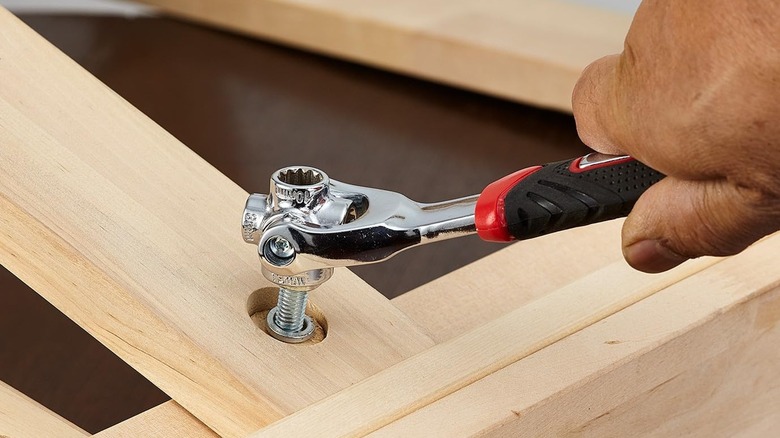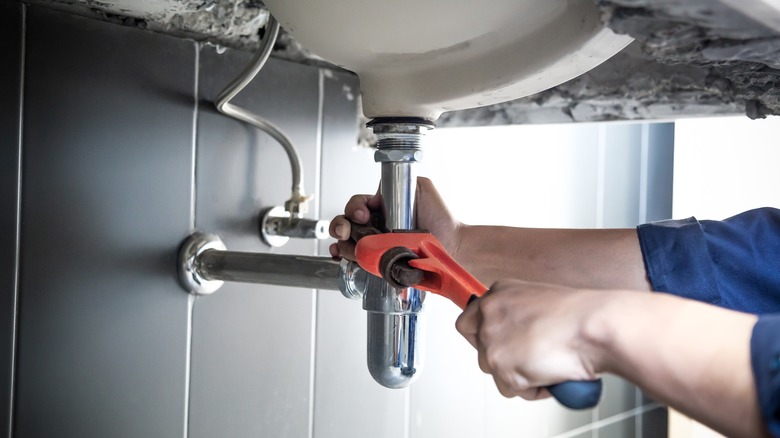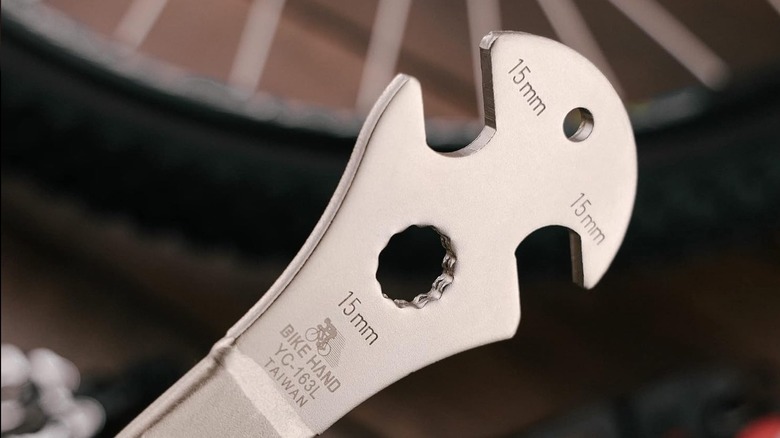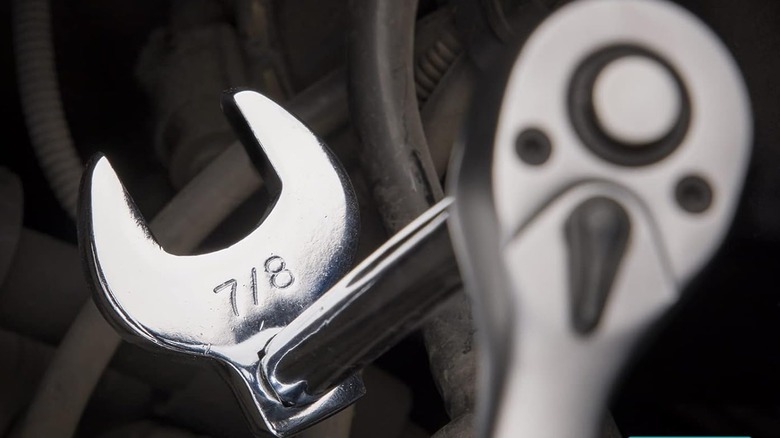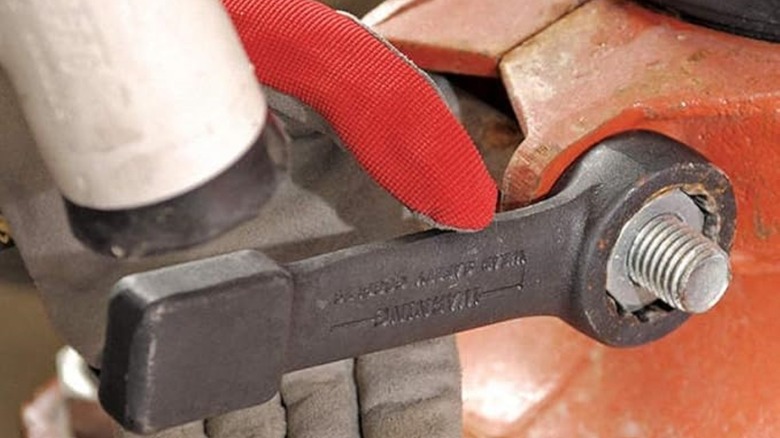12 Types Of Wrenches Homeowners Should Have (And When To Use Them)
We may receive a commission on purchases made from links.
No toolbox would be complete without a wrench. When you're completing a basic DIY project that involves tightening bolts or you're tackling tougher tasks involving pipes, you won't get very far without a wrench. However, did you know that there are different types of wrenches and that some are better suited (or even essential) for certain tasks? For example, the wrench you'll want to grab to tighten (or loosen) a pipe will look quite different from the one you'll need to remove a bike pedal.
There are over 40 types of wrenches but it's unrealistic — and unnecessary — for every homeowner to own them all. It's similar to thinking you need every specialized type of hammer. However, there are a few essential wrenches you might want to keep in your toolbox for everyday home maintenance or specific DIY projects. Read on to discover some of the most common types of wrenches, what they're used for, how you should use them, and whether they're something you'll want to add to your toolbox.
Crescent wrenches are great for nuts and bolts
Crescent wrenches are versatile tools that you can use to tighten or loosen nuts and bolts of varying sizes, making them perfect for anything from plumbing jobs to assembling furniture. Unlike the fixed width of some other wrenches, this tool features an adjustable jaw. You can make the jaw's opening wider or narrower by turning the worm screw, but the exact range will vary based on the overall size of the tool. Sets, such as the Workpro Adjustable Wrench Set, feature multiple crescent wrenches of varying sizes to better accommodate nuts and bolts of different sizes.
To use a crescent wrench, you'll first want to adjust the jaws to ensure they fit snugly around the fastener you need to tighten or loosen. Position the wrench so that you'll be turning it towards the part of the jaw that moves (doing so will help prevent it from slipping). Once in position, pull the wrench towards you, taking care to keep the wrench from slipping. These tools are sometimes referred to as knuckle-busters. This is because users often bang their knuckles against the surface they're working with if the wrench slips.
Another reason to consider a set with multiple wrench sizes is that it will help you match the space constraints of each task. If you're trying to loosen a bolt in a tight space, you'll want a shorter wrench that you'll be able to move more easily. Overall, crescent wrenches are a very useful tool thanks to their adjustability and overall ease of use. This is one that you might want to stock in your toolbox to help you tackle a variety of home improvement and DIY projects.
Box wrenches are great for confined spaces
Box wrenches are easy to identify by their two closed ends. Thanks to its angled head, it can be used to tighten or loosen nuts and bolts in hard to reach or confined spaces, making it perfect for jobs like securing pipe fittings under the sink or attaching a fixture to the wall where it can be difficult to get to the bolt. It's also great to use when you need some extra torque, such as when you need to remove a rusty fastener. When there is adequate space to use a box wrench, you don't have to worry about it slipping off of the nut or bolt you're working on. This can make it a better choice than an open-ended or crescent wrench.
Box wrenches are generally designed for use with nuts or bolts with either six or 12 sides. 12-sided sets — like the Duratech Offset Box Wrench Set — might be a good fit for DIYers and other non-specialized workers. These models can be used to tighten both hex nuts and bolts as well as 12-sided ones, so they can save you from having to buy more specialized tools.
Open-end wrenches are best for fast, easy projects
As you can probably guess based on their name, these wrenches have an open end — sometimes two open ends. They work similarly to a crescent wrench without the adjustability. For this reason, it is essential to have the right size wrench for each job. The wrench you choose must fit snugly around the nut or bolt you need to adjust. If the wrench is too small, you won't be able to get it around the nut or bolt, and if it is too big, it won't be of much use.
You want to use this wrench for fast, small projects where you don't need a lot of torque, don't need much grip, and where you would be doing fast, repetitive movements where the constant adjustment of a box wrench would slow you down. Use it for simple projects like quickly assembling small pieces of furniture or doing routine maintenance on things with loads of bolts, like garden tools or doors. When you look at an open-end wrench, you might notice that the mouth is slightly angled. When placing the wrench over the fastener you're adjusting, make sure that the side that is a bit more open is closest to the direction you'll be pulling. This will help keep the wrench from slipping.
One other note about open-end wrenches. Because nuts and bolts may be sized based on different systems, either SAE or metric, you'll need to ensure that the wrench you choose matches the same system; otherwise, it won't fit properly. You'll find metric wrenches, like the Workpro Metric Super-Thin Open End Wrench Set, as well as SAE wrenches, like the Duratech Super-Thin SAE Open End Wrench Set.
Combination wrenches are great for projects that would require both box and open-ended wrenches
A combination wrench is probably one of those tools that every homeowner should have. It features one end that is a box wrench and one end that is an open wrench. Because of their double-sided design, you can use a combination wrench for tasks that would require both a box wrench and an open-ended wrench. For instance, if you're working on a project that will require both quick adjustments for smaller fasteners and high-torque movements for bigger bolts — such as fixing a car engine — or both accessible and hard to reach bolts, like putting together large, clunky furniture. If you are just an occasional DIYer, you might find it more economical to invest in a combination wrench set than purchasing a full set of both types of wrenches.
Again, it will be essential to match the size of the wrench opening with the size of the fastener you need to adjust. There are both SAE and metric combination wrenches. You'll need to know the type of bolt you're adjusting to ensure you choose the right product. You could also look for a set that offers both SAE and metric wrenches, such as the Efficre 14-Piece All-Purpose Master Combination Wrench Set, to cover your bases and make sure you're prepared for different needs.
Allen wrenches are essential for hex bolts
Allen wrenches, sometimes called Allen keys or hex keys, look different from most other wrench types. If you've ever bought and assembled IKEA furniture, then you've likely seen an Allen wrench since they are often included with the assembly materials. Instead of going around the outside of a nut or bolt, this type of wrench is designed to fit inside the fastener. Because of their specialized design, you'll want to reach for an Allen wrench anytime you're loosening or tightening hex bolts. While you might be able to improvise something and get a screwdriver or another tool to work, you run the risk of damaging the fastener.
An Allen wrench is often shaped like an L. Both of its ends have a hexagonal shape designed to fit into the inset of many bolts. As with other wrench types, size is key (and these tools also come in metric and SAE variations). Allen wrenches can be very thin or very wide, and the one you use must fit snugly inside the fastener or it may strip it. The tools that come with unassembled furniture will be the right size for the bolts for that specific piece. You can also pick up a set of Allen wrenches, like the Efficere 30-Piece Premium Hex Key Set. That way, you don't have to remember which tool goes with which piece of furniture, since each may be slightly different.
Socket wrenches are used to tighten or loosen difficult nuts and bolts
Socket wrenches are commonly used by mechanics, construction workers, and other professionals. However, depending on the types of DIY projects you undertake, and how frequently you might use one, investing in a socket wrench set like the Egofine 46-Piece Socket Ratchet Wrench Set may be a good idea. These tools perform the same task of tightening nuts and bolts that you could accomplish with an open wrench, crescent wrench, or box wrench. However, their ratcheting design makes the task less strenuous. For this reason, reach for a socket wrench when you need the extra power to loosen a tighter nut or will be fastening several nuts and bolts and want to avoid placing strain on your hands and wrists. For example, when working on an engine or loosening rusted bolts on patio furniture.
Instead of having to continuously adjust and pull the wrench, often with all of your might, the ratcheting design of a socket wrench delivers torque to adjust bolts more easily. Like a box wrench, you use a socket wrench by placing it over or around the nut or bolt you're loosening. However, unlike a box wrench, you don't need to turn a socket wrench all the way around the bolt or lift it up and reposition it several times. Instead, the ratcheting system keeps the head locked in place and allows you to pull it towards you to tighten or loosen the fastener.
Impact wrenches are power tools that make quick work of projects like replacing tires
Impact wrenches, like the Milwaukee Mid-Torque Impact Wrench, are another variety to know about, but not one that all homeowners will need. As power tools, these wrenches deliver more torque for quickly loosening or tightening many nuts and bolts. If you're only working on smaller projects with a few nuts and bolts to loosen, they may not be worth the investment. However, if you need the extra force, such as for rapidly changing car tires or driving large fasteners into wood when renovating, then an impact wrench might be the right tool for you.
Like some other wrench types, impact wrenches fit around the nut or bolt that you need to adjust. Once in place, you turn the tool on and let it do the heavy lifting (or, more appropriately, heavy adjusting) for you. Impact wrenches are sometimes confused with impact drivers, but the two tools are not the same. While impact wrenches are used with hex-head fasteners, impact drivers are designed to drive screws into a variety of surfaces. You can find adapters to convert an impact wrench into an impact driver, but doing so isn't always the best idea. It could end up delivering too much power that you strip the head of the screw.
Dog bone wrenches are great for working with varied fastener sizes in tight spaces
Aptly named because of its shape, a dog bone wrench features a center rod with two large ends. The ends rotate, providing you with four different-sized box-style wrenches on each. So, in total, you'll have eight different wrench heads ready for use. Just turn the head until you find the right size opening for the nut or bolt that you need to loosen or fasten. A benefit of the dog bone wrench is its ability to fit into tighter areas. The rotating design of the head means you can offset the angle, giving you more room to work. Because of this, it can be a good tool for those who work on bikes, engines, or other projects with tight quarters but varied fasteners.
Another benefit of a dog bone wrench, such as the Lichamp 48-in-1 Dog Bone Wrench, is how easily portable it is. By bringing just one tool with you, you'll have access to eight different wrench heads. This can make it more practical than box, open-end, or combination wrench sets depending on the location of the job. Plus, if you don't know which wrench size you need, using a dog bone wrench can save you from the trial and error (and the trips to the tool chest) of searching for the right fit.
Pipe wrenches are essential for plumbing projects
Pipe wrenches, often called plumber's wrenches, feature an adjustable head. They have vertical jaws that you can open and close using the knob on the side. With this design, they are ideal for working on pipes, and a tool you might want to have on hand if you're attempting any plumbing repairs. If you always call a plumber for bathroom leaks or repairs, then you might not need to invest in this tool, but you'll probably see the professionals using one.
One other distinction between pipe wrenches, such as the Performance Tool Heavy-Duty Adjustable Straight Pipe Wrench, and many other varieties comes down to the design of their jaws. Beyond opening and closing vertically, the two parts of the jaw are not 100% parallel. Instead, the top jaw is tilted a bit, and they are both serrated. The serration, combined with the slightly off-set design, helps you get a good grip on pipes.
Pedal wrenches are designed for removing or working on bike pedals
Any cycling enthusiast's toolbox isn't complete without a pedal wrench. As you can probably guess based on their name, these wrenches are designed for working with bike pedals. While a box wrench, crescent wrench, or open wrench could often perform the same tasks as a pedal wrench, these other types are often too wide to fit. Conversely, pedal wrenches feature a much thinner and more compact size, making them a good tool for getting into the tighter spaces around bike pedals. For this reason, if you're going to be spending a lot of time working with bikes, you might want to invest in the perfect tool for the job.
When shopping for a pedal wrench, consider the overall design of the tool. One component to note is the length of the handle. A wrench with a longer handle will deliver more leverage, which can come in handy if the pedal is stuck. Similarly, a padded or ergonomic handle can also make these tools easier and more comfortable to use. Many pedal wrenches, like the BikeHand Pedal Wrench, also include a spanner in their design. This added feature makes these tools more versatile, allowing them to help you tighten or loosen the hub bolts on your bike wheels.
Crowfoot wrenches are useful to access bolts in deep spaces that box wrenches can't get to
Does it seem like the nut or bolt you need to get to with a wrench is always in a tight space or one that's nearly impossible to reach? If you're frequently frustrated by this challenge, then a crowfoot wrench, like the Duratech Drive Crowfoot Wrench Set, might be for you. As you might guess based on its name, this type of wrench looks similar to a crow's foot. It features a short handle that connects to a wrench head. Unlike other wrenches that are mostly flat, the wrench head runs perpendicular to the handle, much like how a foot sticks out from the end of a leg.
As mentioned earlier, the benefit of a crowfoot wrench is its ability to get into tighter spaces. Because of the handle design, you don't need to worry about having space to rotate it around the bolt or nut. It's similar to a box wrench in that it can help access bolts in hard-to-reach spaces, but thanks to its angled and flat design, it can get to even tighter or trickier spots, like around pipe obstructions, mechanicals inside walls, or places with minimal clearance, like engines. To use a crowfoot wrench vertically, you'll need to have a compatible ratchet. Once the foot is aligned with the bolt that needs to be adjusted, attach it to the ratchet and work carefully to tighten or loosen the nut or bolt.
Striking wrenches are perfect for rusty or frozen nuts and bolts
If you need to tighten or loosen rusty or frozen nuts or bolts, a striking wrench, like the Urrea Offset Striking Wrench, can help you get the job done. Striking wrenches may have either an open end or a box end (with both metric and SAE options available). They have a relatively short body with a large block on the opposite end of the wrench head.
This design allows you to use a hammer to strike the wrench (hence the name) to deliver additional force. This helps loosen or tighten rusty or frozen nuts and bolts that may otherwise be challenging or nearly impossible to adjust. Depending on the types of tasks that you need to complete, you can find striking wrenches with either straight or offset handles and other features, such as being tether-ready or non-sparking for use around flammable materials.

